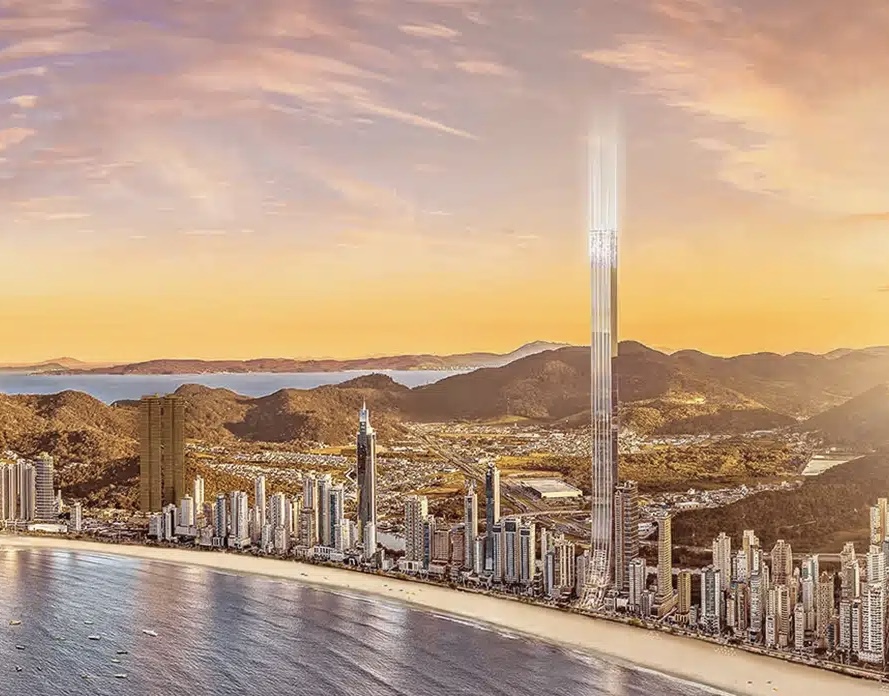
The race to the sky is one that has fascinated architects, developers, and city planners for decades, with nations across the globe vying to set records with towering structures. While the Burj Khalifa in Dubai continues to reign as the world’s tallest building at 2,722 feet, residential skyscrapers have emerged as a unique category within this race, presenting their own set of challenges and aspirations. Enter Senna Tower, an upcoming skyscraper in Brazil set to become the world’s tallest residential building, a project named and themed after Formula 1 legend Ayrton Senna.
Located in São Paulo, Brazil’s economic hub, the Senna Tower will feature 228 residences, offering breathtaking views and opulent living spaces. It’s not just the building’s height—an estimated 1,200 feet—that sets it apart, but the concept and symbolism it embodies. The tower’s name is a tribute to Ayrton Senna, a Brazilian icon known for his racing prowess, relentless pursuit of excellence, and national pride. This association imbues the project with a sense of ambition and purpose beyond mere scale, connecting it to the broader cultural and aspirational values of Brazil.
A Tall Order: Standing Out in the Skyline
While the world has no shortage of tall buildings, only a few manage to leave a lasting impression. The challenge for residential skyscrapers like Senna Tower is not just in achieving an impressive height, but in ensuring that the building maintains functionality, safety, and livability for its residents. Unlike mixed-use or commercial buildings that can accommodate various structural reinforcements and expansive empty spaces, residential skyscrapers must be designed to maximize usable area, comfort, and luxury while minimizing structural bulk and complexity.
The Senna Tower aims to overcome these challenges through innovative design and engineering solutions. Its slender structure, balanced proportions, and cutting-edge materials are expected to provide a sense of lightness and grace, ensuring that the building doesn’t dominate the skyline with brute force but rather integrates harmoniously with its surroundings. This feat of engineering, combined with luxurious interiors and amenities, will likely set a new benchmark for residential skyscrapers globally.
A Symbol of National Pride and Ambition
Brazil’s choice to name this record-setting structure after Ayrton Senna carries significant cultural weight. Senna, a three-time Formula 1 World Champion, was known for his dedication, passion, and sheer willpower—qualities that resonate deeply within Brazilian society. Naming the tower after him not only elevates the building’s stature but also ties it to a figure who symbolizes resilience and national pride. The Senna Tower is not just an architectural marvel; it’s a monument that aims to reflect the country’s aspirations and potential on the global stage.
The theme will likely extend beyond the name, with design elements and aesthetics inspired by Senna’s legacy. Details such as sleek lines, aerodynamic forms, and possibly even nods to his iconic yellow helmet could be woven into the building’s architecture and interiors, creating a cohesive identity that celebrates both form and function. For residents, the building promises not just a place to live but an immersive experience that resonates with the spirit of speed, elegance, and excellence.
Challenges and Prospects
Building a skyscraper of such magnitude is never without its hurdles, and the Senna Tower is no exception. Economic instability, regulatory approvals, and engineering complexities all pose potential challenges to the project’s completion. Moreover, the very concept of towering residential buildings brings with it unique questions regarding safety, accessibility, and environmental impact. Brazil’s construction industry will need to navigate these issues carefully, ensuring that the tower not only meets aesthetic and structural goals but also adheres to stringent safety and environmental standards.
Nevertheless, the potential rewards are immense. For São Paulo, the Senna Tower represents a beacon of progress and modernity, a structure that could catalyze further urban development and put the city on the map as a global architectural destination. For the residents, the tower offers an unparalleled living experience, combining exclusivity, luxury, and a sense of belonging to something monumental.
Impression
The Senna Tower’s journey to becoming the world’s tallest residential skyscraper is more than just a quest for records—it’s an effort to redefine what it means to live in the sky. Named after a national hero, the building aims to be a testament to Brazil’s ingenuity and drive, a structure that inspires as much as it impresses. Whether it will achieve this vision remains to be seen, but its very conception marks a bold step forward in the evolution of residential architecture and the legacy of high-rise living.
No comments yet.








